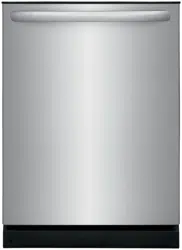Loading ...
Loading ...
Loading ...

16
TROUBLESHOOTING
• Cups with a concave bottom will
collect water. Load them at the far
left and right of the upper rack so
they will be held in a tilted position.
Drying Tip
• Select the Normal Wash and High
Temp option along with a Rinse
Aid agent for improved drying
performance.
• Containers, bowls, pots/pans, and
any dishware with concave surfaces
that can collect water should be
placed in the rack facing or angled
down so that water is able to drain
even from the lowest point.
• Plastic items may need to be towel
dried.
Glassware/Flatware Spotted or Cloudy
• Check water hardness. For extremely
hard water, it may be necessary
to install a water softener. (See
Detergent Chart).
• Water temperature may be low.
Avoid extremely low or high
temperatures. (See Factors Aecting
Performance).
• Avoid overloading and improper
loading. (See Preparing and Loading
Dishes).
• Use fresh detergent. Old detergent
is ineective.
• Make sure rinse aid dispenser is filled.
• Check to see that proper amount
of detergent is being used for cycle
selected. (See Detergent Dispenser).
• Home water pressure may be too
low-it should be 20 to 120 pounds
per square inch (psi).
Dishware Chipped
• Load with care and do not overload.
(See Preparing and Loading Dishes).
• Place delicate items in top rack.
• Place glasses securely against pins
and not over pins.
• Load items so they are secure and
don’t jar loose when moving racks in
and out. Move racks in and out slowly.
• Make sure tall glasses and stemware
will clear top of tub when rack is
pushed in.
• Fine antique china and crystal should
be hand-washed.
Before You Call
Review this list before calling for service.
It may save you both time and expense.
This list includes common experiences
that are not the result of defective
workmanship or material in your
dishwasher.
Food Soils Left on Dishes
• Choose another cycle for longer
washing time.
• Check rack loading section for proper
loading-avoid nesting items.
• Home water pressure may be too
low-should be 20 to 120 pounds per
square inch (psi).
• Check incoming water temperature.
It should be about 120
o
F (49
o
C). (See
Factors Aecting Performance).
• Check water hardness. For extremely
hard water, it may be necessary
to install a water softener. (See
Detergent Chart).
• Use Fresh Detergent.
• Make sure items are not blocking the
spray arms, preventing them from
rotating.
• Do not overload the dishwasher (See
Preparing and Loading Dishes).
• Check to verify that the glass trap
is maintained and installed properly
(See Care and Cleaning).
Dishes not Dry
• If you have not selected Max or Heat
Dry, and no LEDs are illuminated for
these Options, then the heater has
been de-activated during the drying
phase of the selected Wash Cycle. This
is known as Air Dry. Air Dry slightly
lowers the energy usage but increases
the likelihood that the dishware will not
be completely dried.
• Selecting Heat Dry, High Temp or
Sanitize Temp options will improve
drying performance.
• Make sure the rinse aid dispenser is
filled.
• Increase the discharge setting of rinse
aid. (See Rinse Aid).
• Check the incoming water
temperature. Be sure it is at least
120
o
F (49
o
C).
• Check for proper loading-avoid
nesting items.
Loading ...
Loading ...
Loading ...
